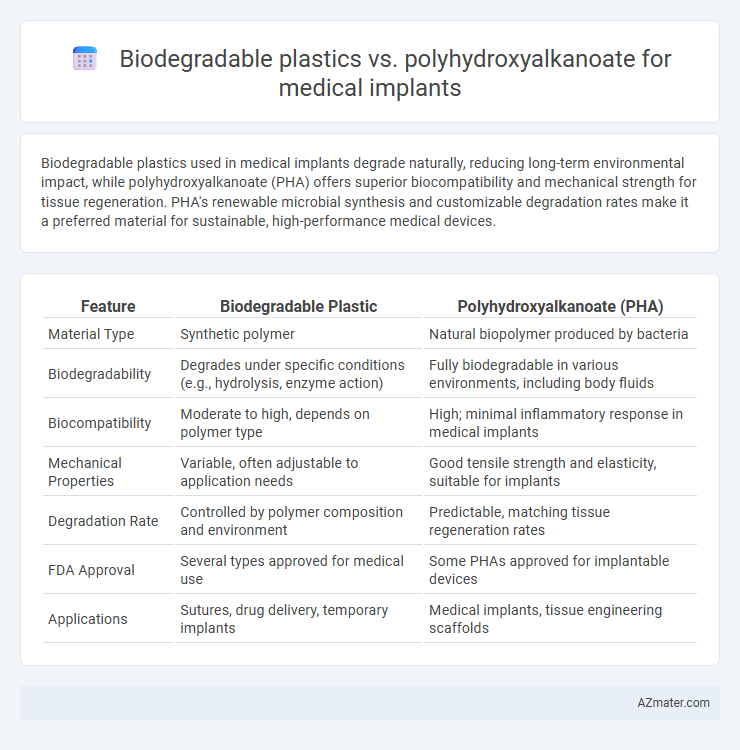Biodegradable plastics used in medical implants degrade naturally, reducing long-term environmental impact, while polyhydroxyalkanoate (PHA) offers superior biocompatibility and mechanical strength for tissue regeneration. PHA's renewable microbial synthesis and customizable degradation rates make it a preferred material for sustainable, high-performance medical devices.
Table of Comparison
| Feature | Biodegradable Plastic | Polyhydroxyalkanoate (PHA) |
|---|---|---|
| Material Type | Synthetic polymer | Natural biopolymer produced by bacteria |
| Biodegradability | Degrades under specific conditions (e.g., hydrolysis, enzyme action) | Fully biodegradable in various environments, including body fluids |
| Biocompatibility | Moderate to high, depends on polymer type | High; minimal inflammatory response in medical implants |
| Mechanical Properties | Variable, often adjustable to application needs | Good tensile strength and elasticity, suitable for implants |
| Degradation Rate | Controlled by polymer composition and environment | Predictable, matching tissue regeneration rates |
| FDA Approval | Several types approved for medical use | Some PHAs approved for implantable devices |
| Applications | Sutures, drug delivery, temporary implants | Medical implants, tissue engineering scaffolds |
Introduction to Biodegradable Plastics in Medical Implants
Biodegradable plastics in medical implants offer the advantage of gradual degradation within the body, eliminating the need for surgical removal and reducing long-term complications. Polyhydroxyalkanoates (PHAs) represent a class of biopolyesters produced by bacterial fermentation, exhibiting excellent biocompatibility and tailored mechanical properties ideal for temporary implant applications. The controlled degradation rate of PHAs aligns with tissue healing processes, making them a superior alternative to traditional biodegradable plastics such as polylactic acid (PLA) and polycaprolactone (PCL) in biomedical uses.
Polyhydroxyalkanoate (PHA): An Overview
Polyhydroxyalkanoate (PHA) is a biodegradable polymer synthesized by microbial fermentation, offering exceptional biocompatibility and controlled degradation rates ideal for medical implants. Compared to traditional biodegradable plastics, PHA exhibits superior mechanical properties and reduced inflammatory responses, crucial for applications like tissue engineering and drug delivery systems. Its renewable origin and ability to be tailored at the molecular level enhance its potential as a sustainable and effective material in advanced biomedical devices.
Key Properties of Biodegradable Plastics for Implants
Biodegradable plastics for medical implants demonstrate critical properties such as biocompatibility, controlled degradation rate, and mechanical strength tailored to support tissue healing. Polyhydroxyalkanoate (PHA), a type of biodegradable plastic, offers enhanced biocompatibility and tunable biodegradability through microbial synthesis, making it ideal for temporary implants. The key properties include non-toxicity, sufficient elasticity, and the ability to degrade into non-harmful byproducts that match the tissue regeneration timeline.
Mechanical Strength: Biodegradable Plastic vs PHA
Biodegradable plastics like polylactic acid (PLA) provide moderate mechanical strength suitable for temporary medical implants but may degrade too rapidly under physiological conditions. Polyhydroxyalkanoates (PHAs), especially polyhydroxybutyrate (PHB), exhibit superior tensile strength and elasticity, supporting longer-lasting mechanical integrity in medical implant applications. The enhanced biomechanical properties of PHAs make them preferable for load-bearing implants requiring sustained durability during tissue regeneration.
Biocompatibility and Safety Profiles
Polyhydroxyalkanoates (PHAs) exhibit superior biocompatibility and safety profiles compared to conventional biodegradable plastics in medical implants due to their natural origin and non-toxic degradation products. PHAs support cell adhesion and proliferation while minimizing inflammatory responses, making them ideal for long-term implant applications. Conventional biodegradable plastics often risk acidic byproduct accumulation, potentially causing local tissue irritation and compromising implant safety.
Degradation Rate in Biological Environments
Biodegradable plastics such as polylactic acid (PLA) and polycaprolactone (PCL) exhibit variable degradation rates depending on molecular weight and crystallinity, typically degrading over months to years in physiological conditions. Polyhydroxyalkanoates (PHAs) demonstrate a more controlled and tunable degradation rate in biological environments, breaking down via enzymatic hydrolysis into non-toxic byproducts within weeks to months. The enzymatic degradation of PHAs allows for customized resorption rates suited to different medical implant applications, offering advantages over conventional biodegradable plastics that rely mainly on hydrolytic degradation.
Applications of Biodegradable Plastics in Medical Devices
Biodegradable plastics, including polyhydroxyalkanoates (PHAs), are increasingly used in medical devices due to their ability to safely degrade within the body, eliminating the need for surgical removal. PHAs, a type of biopolymer produced by microbial fermentation, offer excellent biocompatibility and mechanical strength, making them ideal for applications such as sutures, tissue engineering scaffolds, and drug delivery systems. Compared to conventional biodegradable plastics, PHAs provide superior tailored degradation rates and reduced inflammatory responses, enhancing patient outcomes in implantable medical devices.
PHA in Advanced Medical Implant Technology
Polyhydroxyalkanoates (PHAs) offer superior biocompatibility and controlled biodegradation rates compared to conventional biodegradable plastics, making them ideal for advanced medical implants such as tissue scaffolds and drug delivery systems. PHA-based implants minimize inflammatory responses and promote natural tissue regeneration, leveraging their tunable mechanical properties and bioresorbability. Innovations in PHA synthesis and processing enhance their application in customized, resorbable implants that support healing without the risks associated with polymer residue accumulation.
Environmental Impact and Sustainability
Biodegradable plastics and Polyhydroxyalkanoates (PHAs) offer distinct environmental impacts and sustainability profiles in medical implants, with PHAs derived from microbial fermentation exhibiting superior biodegradability and biocompatibility under physiological conditions, reducing long-term ecological footprint. Biodegradable plastics often rely on petrochemical sources, which contribute to carbon emissions and may leave harmful residues during degradation, whereas PHAs are produced from renewable resources and fully metabolize into carbon dioxide and water, enhancing sustainability. The use of PHAs minimizes toxicological risks and supports circular bioeconomy goals, making them a preferable choice for next-generation medical implant materials focused on environmental stewardship.
Future Trends and Research Directions
Polyhydroxyalkanoates (PHAs) demonstrate significant potential in medical implants due to their superior biocompatibility and biodegradability compared to conventional biodegradable plastics like polylactic acid (PLA). Future research trends focus on enhancing PHA's mechanical strength and controlled degradation rates through molecular engineering and composite material development to match diverse implant requirements. Advances in 3D printing and nanotechnology integration are expected to drive innovation in patient-specific implant designs, improving therapeutic outcomes and reducing post-surgical complications.

Infographic: Biodegradable plastic vs Polyhydroxyalkanoate for Medical implant
 azmater.com
azmater.com